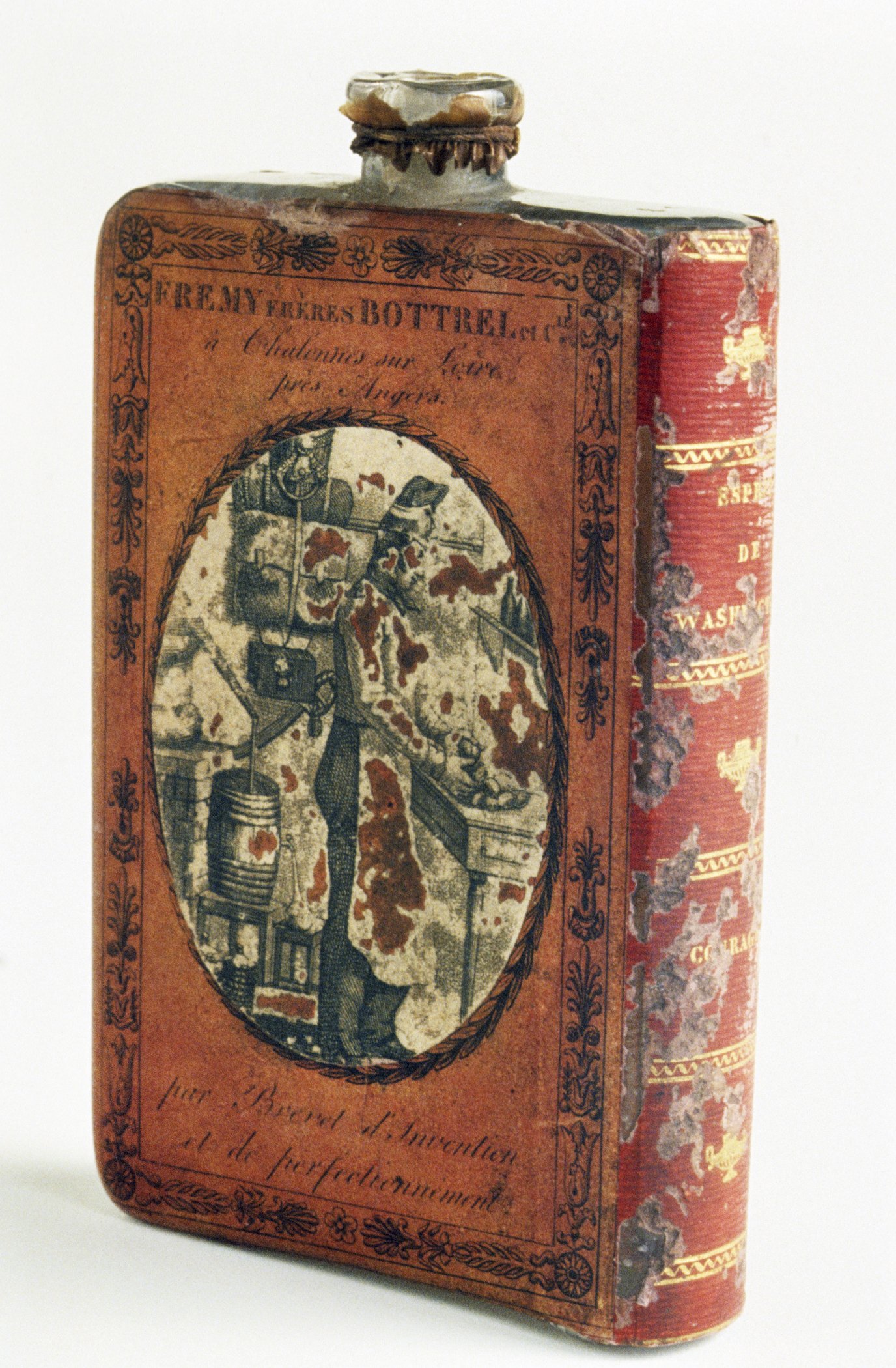Esprit de Washington: The Story of a Patriotic French Flask
 | |
| Fig. 1. Flask (front cover detail), made by Fremy Brothers, Paris, 1800–1830. Museum purchase 1988.0038 |
A biography of George Washington would not seem out of place among the titles of a 19th-century library, but a book on the American figure with a French title would certainly pique one’s curiosity. The intrigue would only continue as one realizes that this particular book was created to contain liquor rather than literature, and in actuality, is a glass flask duplicitously disguised as a book about George Washington. This object is not only hybrid in nature due to its form as both a book and a flask but also due to its connections with both France and America, revealing a constellation of transatlantic connections.
In 1988, Winterthur Museum purchased this unique object from the antiques department at Asprey’s, a London department store. Measuring seven inches in height and four inches in width, the flask’s size does not easily blend in among a collection of books, but its imitation leather spine, gilded lettering, and front and back paper “covers” are convincing (fig. 1). One might assume from the subject matter and the print of Washington on the “front cover”—reminiscent of Charles Wilson Peale’s 1779 painting, Washington at Princeton—that this flask was made for an American audience. Upon closer inspection, however, it becomes clear that the flask’s text, including a poem praising Washington, is written in French rather than English. These verses are attributed to Émile Debraux, a well-known 19th-century French poet and singer who wrote several songs extolling famous French figures, including Napoleon Bonaparte and Jean-Jacques Rousseau. Furthermore, the print of Washington more closely resembles French engraver Noël Le Mire’s 1783 work, Le Général Washington (fig. 2). Finally, the maker and geographical origin of this object are prominently displayed on the back of the object: “Fremy Frères Bottrel et Cie” (Fremy Brothers), a French distillery that primarily produced fruit liquors and whiskey in the 19th century (fig. 3).
 | |
| Fig. 2. Flask (back cover detail), made by Fremy Brothers, Paris, 1800–1830. Museum purchase 1988.0038 |
The legacy of these distillers lies not in their liquid products but in the material traces of the glass objects created to hold and promote these liquors. The Fremy Brothers’ liquor appears to have never made it across the Atlantic Ocean, but this particular flask, attributed to the company, successfully completed the journey as it now resides in an American museum. While this flask is unique among Winterthur collection objects, it is only one title in a series of book flasks manufactured and sold by the Fremy Brothers in the mid-19th century. Book scholar and collector Walter Hart Blumenthal argues that the production of these book flasks was a marketing strategy meant to increase the company’s sales.
In 1822 the Fremy Brothers were issued a “five-year patent for glass bottles of various sizes, having the shape of a book, and intended to contain liqueurs.” A physical representation of this patent is visible as the text on the “back cover” of the flask reads in French: “By Patent of Invention and Improvement.” As the object prominently features the name of their company and is directly related to their primary product, the manufacture and sale of these flasks would have been a profitable endeavor. The wide range of titles available would have also elevated the product to a collector’s item, encouraging consumers to acquire an entire library of book flasks. As these flasks were ultimately created to increase the company’s sales, it can be assumed that the Fremy Brothers chose to include the period’s most popular stories and figures in order to appeal to a majority of the general public and to maximize sales. Examining other surviving flasks created by the Fremy Brothers in museum collections and those that have appeared on the auction market suggest which stories and biographies were necessary titles for a Frenchman’s ideal—and global—19th-century library.
Unsurprisingly, many titles in the Fremy Brothers’ book flask series featured notable French figures, including Voltaire, Rosseau, Louis Pierre Manuel, Molière, and Napoleon Bonaparte. Along with these historical figures, several other titles include stories and myths that would have been well-known by French audiences, such as “The Good Samaritan” and the myth of Cupid and Psyche. Meanwhile, the inclusion of an American icon such as George Washington in this collector’s series not only affirms his sustained popularity among the French public into the mid-19th century but also indicates French knowledge and admiration of non-French figures, particularly those associated with the French ideal of liberty. The Fremy Brothers’ book flasks of Benjamin Franklin and Simon Bolivar (who Marquis de Lafayette called the “George Washington of South America”) reinforce this esteem for figures associated with various liberation movements (fig. 4). Debraux’s poem on the front of Winterthur’s flask refers to Washington as the “son of freedom” and lauds him for fearlessly guiding Americans to independence: “Your hand was the first to help the Americans/Raise the banner of Independence.” The inclusion of Washington and other figures of liberation further asserts that the French public held them in high regard, perhaps in an equal or even higher regard than other French figures due to their role in successfully establishing republics.
 |  | |
Left: Fig. 3. Noël Le Mire, Le Général Washington, Paris, 1783–95. Bequest of Henry Francis du Pont 1970.1392. Right: Fig. 4. Fremy Brothers, flask featuring Simon Bolivar, Paris, 19th-century. Courtesy of La Gazette Drouot. | ||
While the Fremy Brothers primarily created this flask to promote their product rather than to commemorate Washington’s accomplishments, the creation of a product for a French market that praises an American figure immediately places that object into the global context of the 19th-century material world. Examining how American figures were depicted on materials in other nations effectively expands the American material world to include the people, networks, and objects with which America was constantly interacting. Although this object can easily be hidden among other titles in one’s library, the display of its true form and function presents opportunities to unearth the various stories and narratives of 19th-century material life contained within this particular flask.
Cara Caputo is a Lois F. McNeil Fellow, Winterthur Museum, Garden & Library, Winterthur, Delaware.
 |  |  |
 |  |  |















